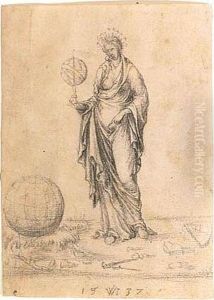Wenzel Jamitzer Paintings
Wenzel Jamnitzer (also spelled Wenzel Jamitzer or Wentzel Jamnitzer) was a Northern Renaissance goldsmith, artist, and printmaker who was born in Vienna, Austria, around 1507 or 1508. He is most famously known for his work in precious metals and his role in the development of Mannerist ornamentation in Northern Europe.
Jamnitzer came from a family of artists and craftsmen; his father was a goldsmith, which was a trade that Wenzel would inherit and excel in. He moved to Nuremberg, which was at the time a hub for artists and craftsmen, and became a master in the city's goldsmiths' guild. In 1534, he was appointed as the court goldsmith for the Holy Roman Emperor Ferdinand I, a role that he would retain under the subsequent emperor, Maximilian II.
Jamnitzer's work was characterized by its intricate design and the use of precious materials. He was particularly adept at creating highly detailed objects such as cups, clocks, and scientific instruments, often decorated with allegorical and mythological scenes. His most famous work is perhaps the 'Neptune cup,' which is an elaborate piece that demonstrates his skill in sculpting figures and his innovative use of form.
In addition to his goldsmithing, Jamnitzer was also known for his theoretical work on the geometric shapes, which he used as the basis for his designs. His most significant publication in this domain was 'Perspectiva Corporum Regularium,' a study of polyhedra and geometric bodies, which was published in 1568. This work not only showcased his artistic talent but also his deep interest in mathematics and geometry, making him a man of both art and science.
Jamnitzer's legacy extends to his influence on the ornamental styles of the late Renaissance and early Baroque periods. His work is preserved in various museums, and his contributions to the goldsmith's craft are still studied by art historians and craftsmen alike. Wenzel Jamnitzer died in 1585 in Nuremberg, leaving behind a body of work that continues to be admired for its beauty and complexity.
